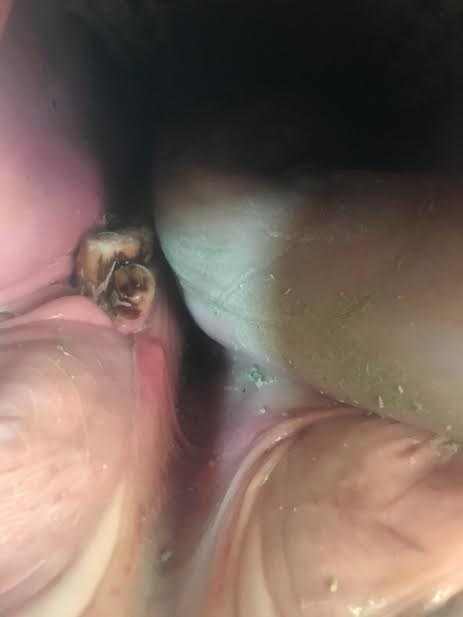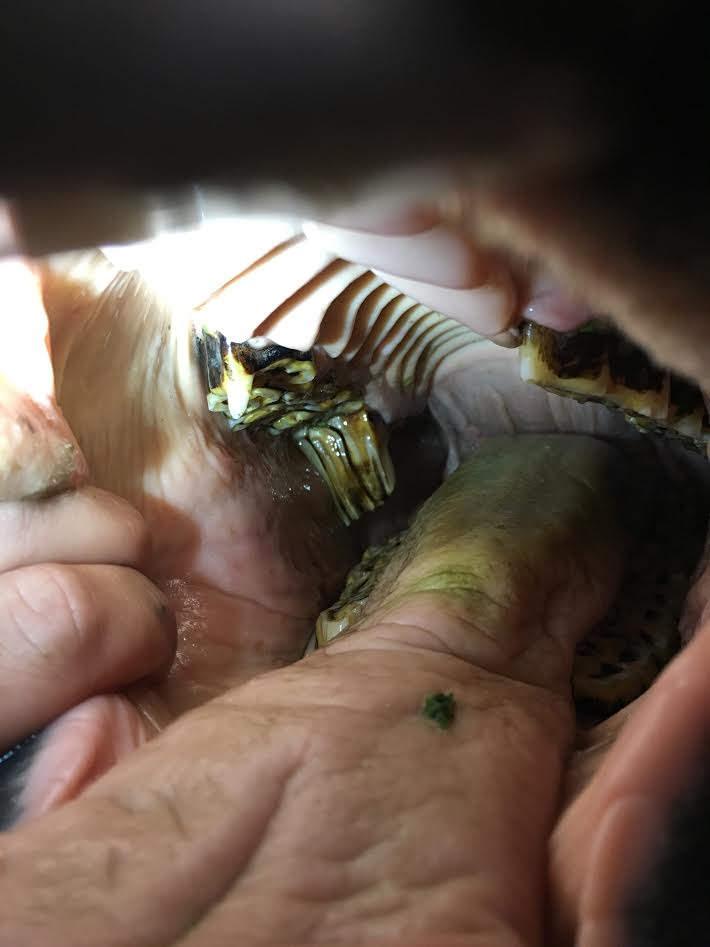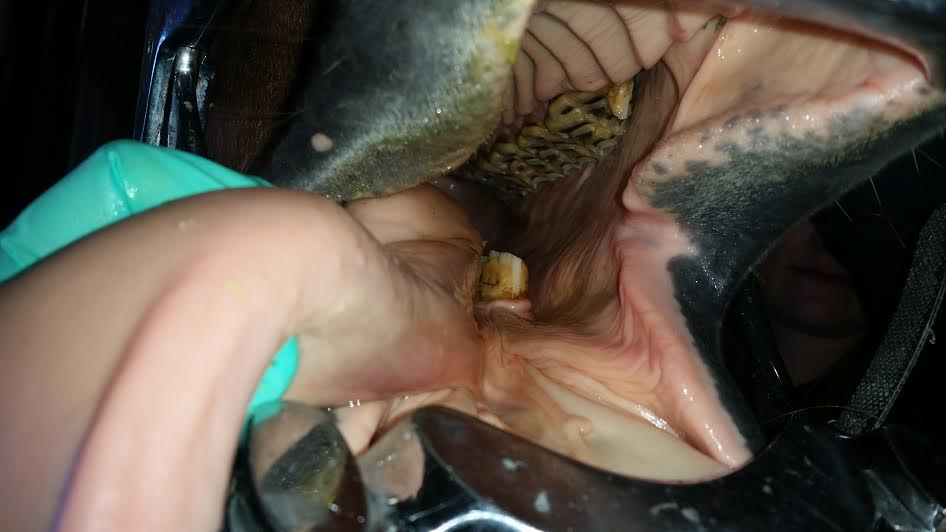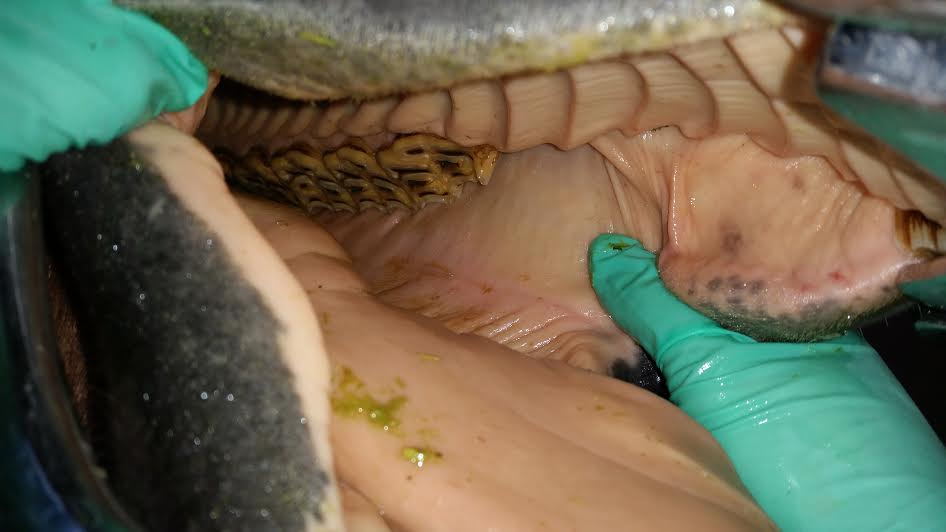Dental Diseases
Horses have a unique dental structure in that they have evolved as grazing herbivores. Like humans, horses have two sets of teeth, deciduous (baby teeth) and permanent teeth. Adult horses have between 36-44 teeth. Dental anatomy can be broken down into 5 different types of teeth. There are 6 upper and lower incisors which are the front teeth horses use for grazing. The next type of tooth is the canine which is unique to geldings and stallions mostly. The wolf tooth is the first premolar or cheek tooth. Horses most often have only 2 erupting from their maxilla or upper jaw. Immediately after the wolf teeth are 6 upper and lower premolars and 6 upper and lower molars. By age 5, most horses have all permanent teeth. The following chart shows approximate ages when different teeth erupt.
| Deciduous (Baby) Teeth | Age |
| 1st incisor | Birth or 1st week |
| 2nd incisor | 4-6 weeks |
| 3rd incisor | 6-9 months |
| 1st,2nd,and 3rd premolars | Birth up to 2 weeks |
| Permanent (Adult) Teeth | Age |
| 1st incisor | 2 ½ years |
| 2nd incisor | 3 ½ years |
| 3rd incisor | 4 ½ years |
| Canines | 4-5 years |
| Wolf teeth (1st premolars) | 5-6 months |
| 2nd premolars | 2 ½ years |
| 3rd premolars | 3 ½ years |
| 4th premolars | 4 years |
| 1st molars | 9-12 months |
| 2nd molars | 2 years |
| 3rd molars | 3 ½ – 4 years |
Routine dental work is essential to your horse’s overall health. There are a variety of dental conditions and dieases that occur within the horse population.
- Wolf teeth- Wolf teeth can interfere with the bit and cause sharp enamel points on the first premolars. Therefore, wolf teeth are most often extracted.
- Sharp enamel points- Sharp enamel points occur on the outer edge of the maxillary teeth and the inner edge of the mandibular teeth. Horses can develop this as early as 2 years of age. Sharp enamel points can cause ulceration within the mouth, thickening of the cheek tissue, performance issues, and weight loss.
- Long hooks or overgrowths on cheek teeth- The second premolar and the third molar are the two places were these develop as a result of improper occlusion. These hooks can cause ulceration and pain to the horse.
- Dominant tooth- A few causes of this include abnormal occlusion and chewing patterns and absent teeth. A dominant tooth will wear the opposing tooth down. This can cause further dental problems including periodontal disease, tooth infections, and possible sinus infections. Horses that have a dominant tooth will have changes in the arcade such as a wave mouth. Dominant teeth need to be reduced to allow the horse to chew properly and will need to be monitored regularly by a veterinarian.
- Periodontal disease- Periodontal disease is very common in the horse population with more than 50 % of the population being affected by this. Periodontal disease begins with bacterial overgrowth within the mouth. One of the common ways for this to occur is when feed is trapped between and around teeth. The gums will become inflamed and may even bleed. Bacteria can enter the bloodstream at this point which can cause general health and reproductive problems. This bacteria will produce enzymes that break down the tooth structure which will cause pain to the horse as it chews. Once the tooth structure has been destroyed, there is little that can be done fo the tooth. Therefore, early diagnosis and treatment of feed pockets and diseased teeth are very important.

Mandibular Wolf Tooth

Dominant Tooth
Below are some signs that your horse may have a dental problem:
- Dropping feed (quidding)
- Turning head while chewing
- Large, undigested feed particles in manure
- Decreased body weight
- Colic
- Behavioral issues such as chewing on the bit, bucking, or rearing
- Malodorous smell coming from the mouth
- Nasal discharge or swelling of the face
A thorough dental exam begins with a general health exam. The veterinarian will look at the overall body condition of the horse and listen for any heart abnormalities. Next, the horse will be sedated. Once the horse is sedated, a dental speculum will be placed within the horse’s mouth to visualize the dental arcade. Once a dental exam is performed, power tools will be used to reduce any sharp points and abnormalities within the mouth. If wolf teeth are present, the veterinarian will extract them at this point. Once the floatation and extractions are complete, further follow-up will be discussed if necessary such as follow-up exams or nutritional recommendations. We do not commonly reverse the sedatives given so we suggest hand walking the horse to help wake him or her up. Lastly, feed should be withheld for the 2 hours after sedation to limit the risk of choke.
Having regular dental exams and dental work performed by your veterinarian will limit the number of problems your horse will experience as he or she ages. Additionally, when your horse can chew comfortably and appropriately, feed utilization will improve and life expectancy increases.

Sharp Enamel Points






